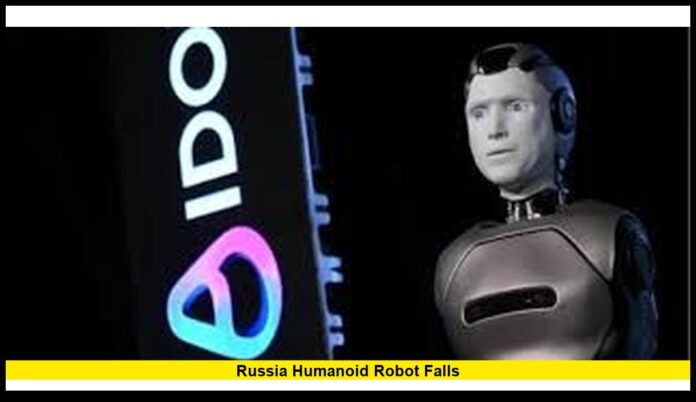At a high-profile technology showcase in Moscow this week, the newly unveiled humanoid robot from Russia experienced a dramatic moment: the key phrase “Russia humanoid robot falls” best captures what happened when the machine slipped, lost balance and collapsed in front of onlookers. The robot, developed by a Russian firm, debuted amidst considerable fanfare, only to stumble and faceplant mere seconds into its demonstration.
What happened
The humanoid robot, standing about 6 feet 1 inch tall and weighing roughly 209 pounds, was introduced on stage to a crowd of journalists and tech-industry watchers. It proceeded awkwardly, then lost its footing as it attempted to wave and walk. The bot fell forward face-first. After the fall, staff rushed onto the stage, pulling a black sheet across to cover the robot while attempting to remove it. The incident quickly circulated online, generating quite a bit of commentary.
According to its developers, the fall was likely caused by calibration issues, lighting/voltage fluctuations or environmental conditions—not necessarily a fundamental design flaw. They stressed that the robot remains in an experimental phase and that the live demonstration was part of ongoing testing.
Technical & program context
- The robot reportedly uses a battery that allows for up to six hours of continuous operation.
- It features around 19 servomotors enabling it to display more than a dozen basic emotions and hundreds of micro‐expressions.
- The developers say it is composed of approximately 73–77 % Russian-made components, with a goal to push that figure above 90 % in future versions.
- Prior to the demonstration the system was tested over various surfaces (carpet, laminate, slippery floor, etc) according to the firm—but the glitch occurred nonetheless.
- The robot’s public outing has been paused temporarily while the balance systems and control software are refined.
Why U.S. audiences should care
For American industry watchers and robotics enthusiasts, the “Russia humanoid robot falls” moment serves as a clear reminder of how difficult robotics and humanoid mobility remain—even for publicly hyped machines. It underscores that:
- The global race for humanoid robotics remains wide open. U.S. companies (and investors) watching this trajectory should take note: a major debut, and major slip-up.
- Even when a country demonstrates ambition and funding, the technical hurdles (balance, perception, power, control) continue to challenge developers.
- For U.S. policymakers and industry strategists, the incident highlights that Russia is still actively developing advanced robotics systems despite sanctions and supply-chain constraints—so keeping track of global competitors remains relevant.
Timeline of the event
| Date | Event description |
|---|---|
| August 2025 | The robotics firm announced registration of the humanoid robot project. |
| November 12-13, 2025 | Official public debut of the robot in Moscow; the robot falls during demonstration. |
| Immediately after | The firm pauses further public demos and begins recalibration of the system. |
Analysis: What went wrong?
The developers pointed to external factors (voltage, lighting, calibration) rather than outright mechanical failure. That said, a live demo collapse raises valid questions:
- Was the balancing or gait algorithm sufficiently mature for stage conditions?
- Were the surface and environment sufficiently controlled—or did real-world conditions expose limitations?
- Does the high percentage of domestically-sourced components pose supply or quality limitations compared with globalised supply chains?
- Does this event reflect a gap between robotics presentation and robotics reliability?
For U.S. observers, the event suggests caution: hype may precede robust performance, and even bold national-level projects can falter in public.
Broader implications
This mishap is emblematic rather than isolated. It reveals how robotics companies—even those backed by governments—face formidable challenges. Some observations:
- Robotics, especially humanoid systems, are inherently complex: dynamic stability, locomotion, perception, power, software all must integrate seamlessly.
- National ambition (Russia’s push to develop a domestically-made humanoid robot) collides with global realities (component supply, engineering talent, software maturity).
- For U.S. stakeholders, it emphasises the need to monitor not just successes abroad but also public failures—these can reveal the true state of technological readiness more than marketing reveals.
What’s next?
- The Russian firm intends to refine the robot’s balance and control systems before further public appearances.
- Future versions may aim to replicate the demonstration without mishap—and increase domestic component share.
- For the U.S. robotics ecosystem, it’s worth watching whether Russia can turn this stumble into a successful rollout, or whether this remains a cautionary tale of ambition over execution.
In sum, the “Russia humanoid robot falls” incident is more than a viral moment—it’s a snapshot of where humanoid robotics stands today: highly visible ambition, but still a long path to reliable, resilient machines. What are your thoughts on this robotic stumble and what it signals for the future of humanoid robots? Feel free to share your comments below and keep an eye on how this story develops.
